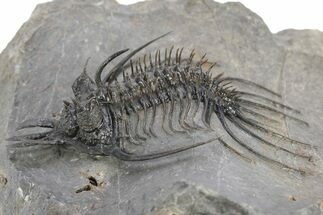This Specimen has been sold.
3.4" Morocconites Trilobite Fossil - Orange Eye Preservation
Here is a 3.4" long, phacopid trilobite (Morocconites malladoides) quarried from the deposits near Ofaten, Morocco. This member of the Phacopida trilobites and has a very defining feature, a long pointed rostrum (snout) coming off of its head. It's unclear what purpose this rostrum would have served, but it could have potentially been used to help it dig through the mud.
This is a beautiful specimen with orange eye facet preservation in both eyes. It has 1-2% shell restoration, primarily the tops of a few axial rings.
This is a beautiful specimen with orange eye facet preservation in both eyes. It has 1-2% shell restoration, primarily the tops of a few axial rings.
About Trilobites
Trilobites are an extinct class of marine arthropods that thrived for nearly 270 million years, from the early Cambrian to the end of the Permian period (around 521 to 252 million years ago). They are one of the most successful and diverse groups in the history of life, with over 25,000 described species spanning a wide range of sizes, shapes, and ecological niches. Known for their distinctive, segmented exoskeletons, trilobites provide invaluable insights into the evolutionary history of arthropods and the dynamics of ancient marine ecosystems.
Trilobites are an extinct class of marine arthropods that thrived for nearly 270 million years, from the early Cambrian to the end of the Permian period (around 521 to 252 million years ago). They are one of the most successful and diverse groups in the history of life, with over 25,000 described species spanning a wide range of sizes, shapes, and ecological niches. Known for their distinctive, segmented exoskeletons, trilobites provide invaluable insights into the evolutionary history of arthropods and the dynamics of ancient marine ecosystems.
SPECIES
Morocconites malladoides
LOCATION
Ofaten, Morocco
FORMATION
Tazoulait Formation
SIZE
3.4" long (if outstretched)
CATEGORY
SUB CATEGORY
ITEM
#317822
We guarantee the authenticity of all of our specimens.
 Reviews
Reviews















